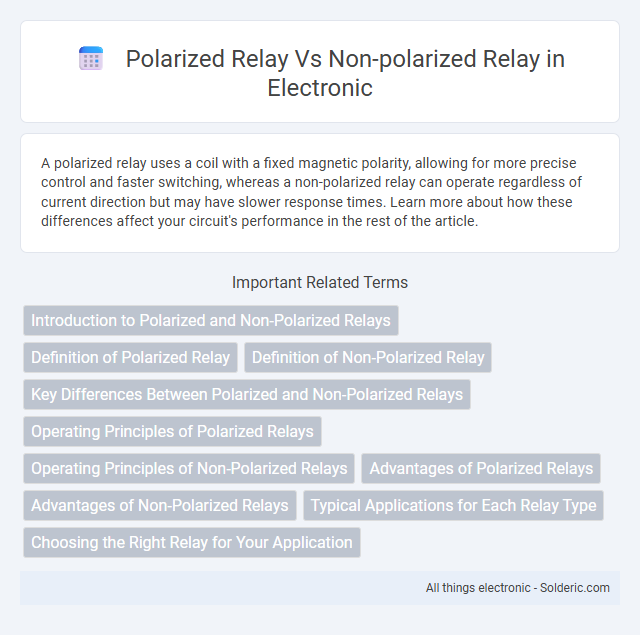A polarized relay uses a coil with a fixed magnetic polarity, allowing for more precise control and faster switching, whereas a non-polarized relay can operate regardless of current direction but may have slower response times. Learn more about how these differences affect your circuit's performance in the rest of the article.
Comparison Table
| Feature | Polarized Relay | Non-Polarized Relay |
|---|---|---|
| Coil Polarity | Requires specific coil polarity | No specific coil polarity needed |
| Contact Protection | Reduces contact chatter, improves contact stability | Higher risk of contact chattering |
| Typical Applications | Audio devices, sensitive control circuits | General switching, simple control circuits |
| Magnetic Design | Uses permanent magnet to maintain armature position | Relies solely on electromagnetic force |
| Cost | Usually higher due to complex design | Generally lower cost |
| Response Time | Faster response with less hesitation | Standard response time |
Introduction to Polarized and Non-Polarized Relays
Polarized relays incorporate a permanent magnet or a polarized coil, enabling them to respond to direct current (DC) signals with precise coil activation and reduced contact chatter. Non-polarized relays operate without polarity sensitivity, allowing them to function effectively with alternating current (AC) or DC, making them versatile in various circuit configurations. The choice between polarized and non-polarized relays depends on application requirements such as signal type, sensitivity, and switching stability.
Definition of Polarized Relay
A polarized relay is an electromagnetic switch designed with a permanent magnet in its coil assembly, enabling it to respond specifically to the polarity of the applied voltage. This polarity sensitivity allows precise control, preventing unintended activation from AC signals or reverse DC voltages. Unlike non-polarized relays, which operate regardless of voltage direction, polarized relays are essential in applications requiring directional current detection and stable switching behavior.
Definition of Non-Polarized Relay
A non-polarized relay operates without requiring a specific direction of current flow through its coil, allowing it to function with alternating current (AC) or direct current (DC). Unlike polarized relays, which depend on coil polarity for proper activation, non-polarized relays rely solely on electromagnetic induction to switch contacts. When selecting your relay, understanding that non-polarized versions offer greater versatility in AC/DC applications can optimize system design and reliability.
Key Differences Between Polarized and Non-Polarized Relays
Polarized relays contain a permanent magnet that ensures the relay coil's DC current flows in a specific direction, providing immunity to reverse polarity and enabling faster response times and quieter operation. Non-polarized relays function with AC or DC currents regardless of coil polarity, making them versatile but potentially slower and noisier due to magnetic fluctuations. Key differences include directional coil sensitivity, application suitability for DC circuits, and overall electromagnetic performance impacting relay longevity and switching precision.
Operating Principles of Polarized Relays
Polarized relays operate using an electromagnetic coil combined with a permanent magnet, which creates a magnetic field that either attracts or repels the armature to open or close contacts based on current polarity. This polarity-sensitive mechanism enables precise control and prevents unintended activation caused by signal fluctuations. Understanding the operating principles of polarized relays helps you select the right type for applications requiring directional control and reliable switching performance.
Operating Principles of Non-Polarized Relays
Non-polarized relays operate by using an electromagnetic coil that generates a magnetic field when current passes through it, causing the relay contacts to either open or close regardless of current direction. These relays do not require a specific polarity to function, making them versatile for AC and DC applications where current direction may vary. Your choice of a non-polarized relay can simplify circuit design by eliminating concerns about coil polarity while ensuring reliable switching performance.
Advantages of Polarized Relays
Polarized relays offer faster response times and increased sensitivity compared to non-polarized relays, making them ideal for precise control applications. Their built-in permanent magnet reduces the power needed to maintain the relay in the energized state, enhancing energy efficiency and reducing wear on components. You benefit from improved reliability and lower operating costs when using polarized relays in your electronic circuits.
Advantages of Non-Polarized Relays
Non-polarized relays offer the advantage of universal coil connection, enabling operation regardless of coil voltage polarity, which simplifies installation and reduces wiring errors. They provide greater flexibility in AC and DC circuits without needing polarity consideration, enhancing compatibility across various applications. Non-polarized relays typically have a simpler design, leading to increased durability and lower maintenance requirements compared to polarized relays.
Typical Applications for Each Relay Type
Polarized relays are commonly used in DC circuits where polarity sensitivity is critical, such as in telecommunications, automotive electronics, and control circuits for precise switching operations. Non-polarized relays find typical applications in AC circuits and general-purpose switching tasks, including household appliances, industrial machinery, and lighting controls where direction of current flow is not a concern. Choosing between polarized and non-polarized relays depends on the specific requirements of load type, voltage characteristics, and control signal polarity.
Choosing the Right Relay for Your Application
Selecting the right relay requires understanding the key difference between polarized and non-polarized relays, where polarized relays include a permanent magnet and require DC control voltage with correct polarity, making them ideal for precise switching and memory functions. Non-polarized relays operate with AC or DC control voltage without polarity sensitivity, offering flexibility and simplicity for general-purpose applications. Evaluating the control voltage type, application environment, and switching requirements ensures optimal relay performance and reliability.
Polarized relay vs non-polarized relay Infographic

 solderic.com
solderic.com